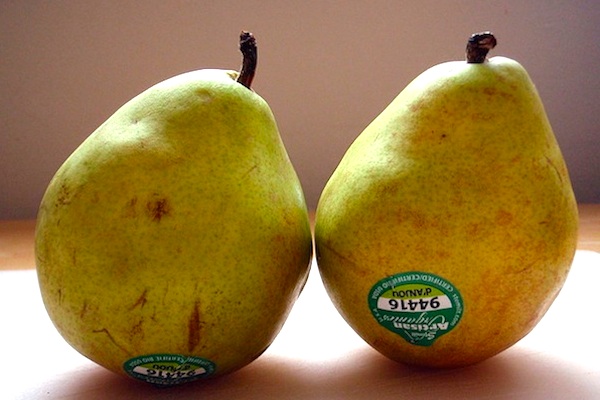If you’re unsure about the nature of supermarket produce, here’s the giveaway.
Some people have strict standards about eating organic fruits and vegetables. Some supermarket produce sections are poorly labeled or in enough disarray that knowing what was grown in which way can be challenging. If either of these fates have ever befallen you, meet your friend, the PLU sticker.
PLU (or Price Look Up) codes are the 4- or 5-digit numbers on produce stickers that have been used by supermarkets since 1990. They represent a globally standardized system implemented by the International Federation for Produce Standards (IFPS), a group of national produce associations from around the globe. While the long-term objective of the organization is to improve the supply chain efficiency of the fresh produce industry, consumers can glean information from the codes as well.
The PLU number indicates produce items based on a number of factors such as commodity, variety, growing methodology (e.g. organic), and size. Numbers are assigned by the IFPS after rigorous review at both national and international levels.
The system is based on 4-digit codes that are within the 3000 and 4000 series. The numbers are assigned randomly, that is, each digit does not imply anything specifically, just an overall identification number. As an example, a small Fuji apple has the code of 4129, a large Fuji apple has the code 4132.
At the supermarket that may not be so helpful in and of itself, until you know this: If the 4-digit number is preceded by a 9, it indicates that it was grown organically. 94416 in the photo above? An organic large Anjou pear; a conventionally grown large Anjou pear would be 4416. So any 5-digit number that starts with a 9 identifies the produce as organic.
At one point the 4-digit number preceded by an 8 indicated a GMO product, but that system is being discontinued because, according to the IFPS, those PLU codes never made it to the retail level anyway and the organization needs more digits to assign for incoming code requests. (I’m guessing I’m not the only one here that would love such an easy way to identify GMO produce, alas.)
Basically, the PLU codes can be helpful to consumers in a few ways. Primarily, as an easy way to identify conventional versus organic produce at the market. (Although the coding isn’t regulated by a governmental agency, IFPS has a lengthy review process and accuracy is important for the retail industry.) But they can also come in handy when you get home and aren’t sure what variety of something you may have purchased. What in the world was that perfect pear? Just type in the sticker’s code at the IFPS database and voila.
All of this said, if you shop at a farmers market, produce there will not be wearing a sticker. But you can also find out in two seconds whether or not the item is organic. Ask the farmer, they’ll tell you much more than a sticker can.
Source: TreeHugger.com
Photo: Joy/Flikr
